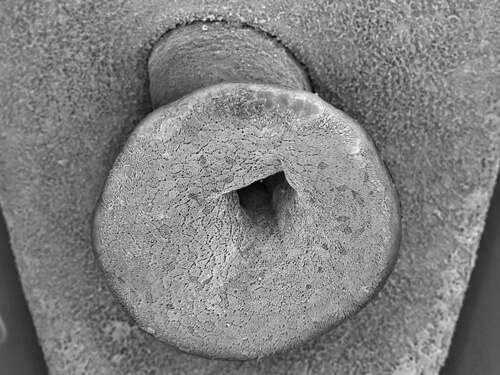What does the Merlin SEM with 3View do?
The Zeiss Merlin SEM at Stowers is like a very, very expensive pocketknife…that’s way too big to fit in your pocket! It can do
three different things. First, it can take very detailed images of the
outside of a specimen, giving fine details about the surface of samples.
This mode looks like super, super, super macro photography.
The Zeiss Merlin can also look at the inside of samples. To do this
we cut a specimen into super thin slices with a diamond knife after it
has been embedded in plastic. How thin? Like so thin that it would take
800 slices to capture the width of the average human hair!
The power of this machine in these modes isn’t solely based on how
you can see super tiny things, but that you can take large, sweeping
fields of view and then zoom in to high resolution wherever you want,
like Google Maps . This lets us and our researchers pinpoint regions of
interest and allows us to align our cell-level biology into the context
of a whole animal.
The last thing it can do with an addition of the 3View module is what
technically makes it a knife (but still too big for a pocket!). It can
take an image of a sample, cut off a thin section of it with a diamond
knife that is in the microscope, and then image the surface the knife
revealed. It does this repeatedly, sometimes running for multiple weeks
24/7, and at the end, we get a 3D volume of high-resolution data.
From outside to inside, and from 2D to 3D, the Zeiss Merlin with 3View brings tiny biology into perspective!
What is the benefit of having this technology at Stowers?
Light microscopy and electron microscopy are synergistic
technologies. Each fills the other’s weaknesses. Light microscopy is
limited by physics and markers. We can only resolve things that are a
certain distance apart. It used to be the limit was ~250 microns; now,
with super-resolution we can get down an order of magnitude to ~40 nm
(or 0.04 microns). We also must be able to use chemicals to stain
tissues, or fluorescent proteins to mark proteins to make them stand out
and provide enough contrast. Electron microscopy can get down another
order of magnitude and resolve structures that are only angstroms apart
(~0.0001 micron). The Zeiss merlin, for what we generally do here at
Stowers looks at structures on the order of 5-50 nm. While it too relies
on staining to create contrast, unlike staining techniques in light
microscopy, the staining allows us to see all the surrounding
structures. This allows our researchers to look at and understand
biology on the smallest of scales but also allows us to zoom out and put
those tiny details into perspective.
What are some of the most exciting discoveries achieved with this technology?
Scanning electron microscopy looking at the outside of specimens
allows scientists to fully understand the normal state of a tissue or
animal and then we use it again to see what happens when we remove the
function of a gene, or when we turn a gene on higher, or in the wrong
place.
Looking at a set of thin sliced sections on this machine allows us to
marry the best of light microscopy and electron microscopy by combining
them with correlative light and electron microscopy (CLEM). We can see a
cell’s molecular identity (light microscopy) and its full structure
(electron microscopy).
The technology of 3D electron microscopy that the 3View offers is
relatively new and it is allowing scientists to understand biology at
the smallest of scales in the context of a whole 3D tissue. Recently, a
groundbreaking paper captured a whole animal at high resolution using
this technology, providing an atlas for their field. Here at Stowers,
we are using it to understand what stem cells and their local
environments look like, as well as using it to characterize and
understand cells and tissues in new research organisms like sea anemones
and apple snails! This new technology is just starting to take off and
promises a lot more to come!




